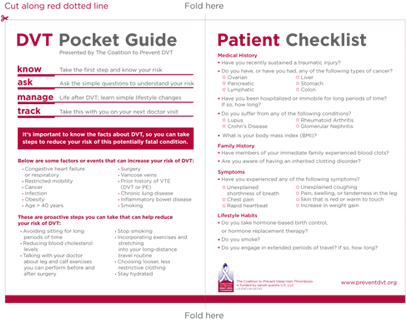Patient Toolkit

It's important to share your concerns about your heath and risk for developing a
DVT with your healthcare professional. Ask questions and be prepared to provide
accurate information about your lifestyle, diet, exercise routine and medications.
The key to DVT prevention is taking small steps that lead to big rewards,
by setting goals and tracking your progress.
To help you make the most of your time with your healthcare professional download
this helpful pocket guide and bring it to your appointment.
Patient Tracker
Recommended for patient use.
This tool can help you and your doctor track your risk of developing a DVT. Before
your next appointment, check any of the boxes that apply and bring it with you to
discuss with your doctor.
Risk Factors
Since my last appointment I have:
Symptoms
I have been experiencing:
Lifestyle Changes
Since my last appointment, I have: